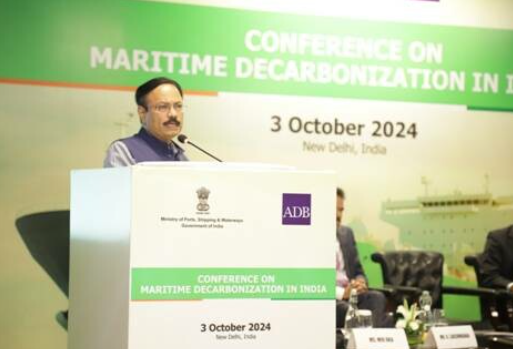India’s Maritime Decarbonization Conference
The Conference on Maritime Decarbonization in New Delhi, co-hosted by the Ministry of Ports, Shipping and Waterways, and the Asian Development Bank, brought together more than 200 participants, including leaders from Indian ports, government officials, and international experts. The goal of the conference was to discuss how shipping and port operations can become more environmentally friendly.
India’s Maritime Sector and Climate Change
In his keynote speech, Secretary TK Ramachandran explained that the maritime sector is crucial for the economy but also plays a key role in fighting climate change. The Indian government is committed to making maritime operations more sustainable, which means they want to reduce pollution and adopt greener practices.
Green Initiatives
The Ministry shared two important guidelines:
Harit Sagar Green Port Guidelines – These are rules to help ports use green energy and become more eco-friendly.
Harit Nauka Green Transition Guidelines – These focus on making shipping more sustainable.
Both guidelines are designed to help ports and ships use clean energy and reduce pollution, serving as models for the entire maritime sector.
India’s commitment to net-zero emissions
The conference emphasized India’s goal to reach net-zero carbon emissions by 2070. This means India wants to balance the amount of carbon dioxide it produces with the amount it removes from the atmosphere. This goal aligns with Maritime India Vision 2030, which focuses on making India’s maritime practices more sustainable in the coming years.
Key Discussion Themes
Several important issues were discussed at the conference, including:
- Building green infrastructure for ports, meaning ports that use eco-friendly energy sources.
- Using clean harbor crafts, or smaller boats that produce less pollution.
- Exploring zero-carbon fuels like hydrogen and ammonia, which do not release harmful emissions.
- Strategies to reduce emissions from ships and ports.
- Electrifying inland waterways, making them run on electric energy instead of fuel.
These discussions are part of a broader effort to make the maritime industry more sustainable and address global climate concerns.
What is Maritime Decarbonization?
Maritime decarbonization means reducing greenhouse gas emissions from ships. Around 90% of global trade is done through ships, but these ships produce nearly 3% of the world’s CO2 emissions. The International Maritime Organization (IMO) aims to reduce these emissions by 50% by 2050. To achieve this, shipping companies are exploring alternative fuels such as ammonia, hydrogen, and methanol. However, switching to these fuels is expensive and requires new infrastructure. Some ships are even using wind-assist technologies to reduce fuel consumption.
Month: Current Affairs - October, 2024
Category: Summits and Conferences








